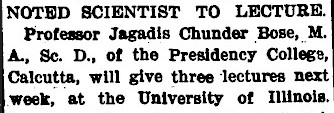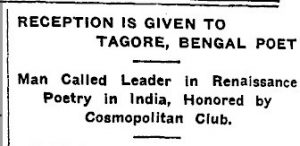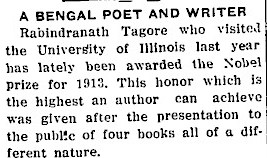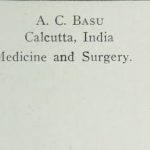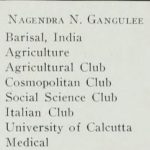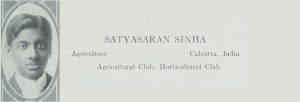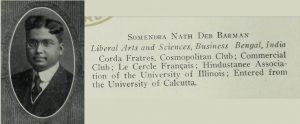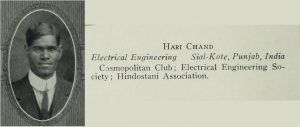Since at least 1906, South Asian students have been attending the University of Illinois. Early South Asian Illini have included actors, agriculturalists, bankers, business executives, chemists, dairy farmers, economists, educators, electrical engineers, journalists, mechanical engineers, political scientists, singers, university professors, and writers too.
Read on to learn more about early South Asian Illini!
Early Illinois – South Asia Connections
Sir Jagadis Chandra and Lady Abala Bose Lectures
- A 1909 Daily Illini announcement for Sir Jagadis’s 1909 lectures, found in Record Series 41/8/802.
- A 1915 Daily Illini announcement for Sir Jagadis’s 1915 lectures, found in Record Series 41/8/802.
In 1909, Sir Jagadis Chandra Bose, a Bengali physicist, and his wife Lady Abala Bose, a well-regarded social worker by her own right, came to campus to give a series of talks, at the invitation of the College of Science. Although Sir Bose was only in town for one week, he and his wife were busy. After arriving on a Friday, Lady Bose gave a Saturday afternoon lecture “Modern Education of Hindu Women” which was followed with a reception. The lecture was well-received, the Daily Illini reported. For the next three days, Sir Bose lectured on “Polarization of Electric Waves“, “Mechanical Responses of Plants“, and “Electric Responses of Plants” in the Chemistry Lecture Room. The lectures were of such significance that one DI writer advised every student to attend at least one lecture. The Boses were invited again in 1915.
Rabindranath Tagore and the Tagore Circle
- A 1912 Daily Illini announcement for Mr. Tagore’s 1912 arrival, found in Record Series 41/8/802.
- A 1912 Daily Illini announcement for a student reception for Mr. Tagore and his wife, found in Record Series 41/8/802.
- A 1913 Daily Illini announcement for Mr. Tagore’s 1913 Nobel Prize for Literature, found in Record Series 41/8/802.
Just three winters later, from late fall 1912 through winter 1913, on 909 West Nevada Street, another Bengali polymath (and soon to be 1913 Nobel Prize for Literature recipient) Mr. Rabindranath Tagore read selections of poetry and spoke to a local group later known as the Tagore Circle. While Mr. Tagore was not an alumni nor was he a member of the University, his son Rathindranath was an alumni in Agriculture. The Tagore family visited town, while Rathindranath completed graduate coursework for a few months, The Daily Illini reported. While Mr. Tagore stayed with Electrical Engineering Professor Morgan Brooks, Rathindranath stayed with Foreign Student Advisor and Spanish Professor Arthur R. Seymour and his wife Mayce, The Daily Illini reported.
While in town, Mr. Tagore gave a series of lectures at the Unitarian Church on Oregon and Mathews (now Unitarian and Universalist Community Center). During the second and third weeks of November, Mr. Tagore gave a four-lecture series on spiritual thought, including The Upanishads (November 17), religion in ancient India (November 23), and Hindu thought as well as the problem of evil (November 27).
Local students enthusiastically met with Mr. Tagore. Within weeks of his arrival, on December 10, at the Cosmopolitan Club House, a reception was hosted. Another week later, the December issue (Volume IV, Number 3) of the student-produced Illinois Magazine (Record Series 15/7/810) included several translated selections of Mr. Tagore’s writing in addition to an introductory essay by Mrs. Seymour. Mr. Tagore would return again during the last week of December 1916.
While just over a decade later, for a few days at the end of September 1927, during a national tour and while staying as a guest at the Kunz family home, even Sushama Tagore visited campus. During her campus lecture, as summarized in The Daily Illini, Miss Tagore emphasized that the uplift of women in India had to come from an education system for them.
Alumni in South Asia
Some early Illinois graduates began their careers either as missionaries or as instructors in higher education which included destinations across South Asia. In fact, multiple Illinois graduates worked in Christian missions in the state of Uttar Pradesh. [1] The first Illini to follow a career in India might have been Mr. George C. Hewes (B.S. Chemistry, 1883; M.S. Chemistry, 1925), of Mendon, Illinois. [2] After graduation, Mr. Hewes taught Chemistry at Illinois for one year, before working for a photographer and as a chemist in Chicago. Then, in 1891, Mr. Hewes had joined a mission in India. By 1896, he had become Professor at Reid Christian College (now Lucknow Christian College) in Lucknow too. From 1907 to 1908, Mr. Hewes was Acting Chaplain for Wesleyan and Presbyterian troops in the British Army in India. In 1911, Mr. Hewes and five other Illini would found the Illinois Alumni association of India.
Just four years after Mr. Hewes, from 1895 until 1897, Ms. Agnes G. Hill (A.B. 1892; B.L., 1893) arrived as the General Secretary of the Y.W.C.A. in Madras. [3] From 1896 through 1912, Ms. Hill was the National Secretary for India, Burma (now Myanmar), and Ceylon (now Sri Lanka).
About nine years after Ms. Hill, in 1904, Mr. Samuel Day Bawden (B. S. Mechanical Engineering, 1890), of Elyria, Ohio, arrived in India as Industrial Missionary to the Telugu people in Andhra Pradesh. [4] From 1906 until 1912, Mr. Bawden worked as Superintendent of Industrial Experimental Station in Ongole, and he was President of the Industrial Missionary Association of India from 1910 through 1912.
Also, Mr. Arthur C. Hobble, (B.S. Electrical Engineering, 1901; M.S. Electrical Engineering, 1911), of Glasford, Illinois, worked as an electrical engineer of the Mysore Government for the Chauvery River Power Station. [5]
Five years after Mr. Bawden, from 1910 until 1915, Mr. Arthur C. Boggess (A.B. Political Science, 1902), of Catlin, Illinois, became the second Illini to teach at Reid Christian College in Lucknow. [6] After completing a PhD in History at the University of Pennsylvania, Mr. Boggess left for India where he became a History and Political Economics Professor at Reid, until returning to the United States to join the faculty of Baldwin-Wallace College in Berea, Ohio. While at Reid, Mr. Boggess was also editor of the The Lucknow Collegian from 1911 until 1915 too.
Ms. Edith E. Boggess, (B.S. Agriculture, 1915), of Catlin, Illinois, would also relocate as a missionary in Lucknow. [7] Ms. Boggess taught at Isabella Thoburn College for one year, before becoming Headmistress in 1917.
Concurrently with Dr. Boggess, Mr. Lawrence C. Powers, (A.B. Science, 1907), of Tiskilwa, Illinois, became a missionary in India too. [8] Beginning in Madura, Mr. Powers later went to Kamuthi and Dindigul, before he became Chairman of the Madura Mission in 1915. He was also a member of the American Board of Commissioners of Foreign Missions. While he was at Illinois, Mr. Powers was a member of multiple high profile student organizations. He was in University Band, the Oratorical Society, a member of the Illini staff, and even president of the multicultural Cosmopolitan Club.
Within two years of graduation, Ms. Florence Somers (later Williams), (A.B. Literature and Arts, 1907), of Panola, Illinois, had her wedding in Chungking, China, before joining a mission in India. [9] After three years, Mrs. Williams and her spouse returned to the United States.
Students
For the first decade, the earliest South Asian Illini came from the area of Bengal (now Bangladesh and Eastern India); although by the end of the decade, other students came from Punjab too. Many of those men studied Agriculture, while a few students studied engineering, chemistry, and journalism.
Class of 1907
- A 1908 Illio profile photo of Mr. Sudhindra Bose, found in Record Series 41/8/805.
The first South Asian student at Illinois might have been Mr. Sudhindra Bose, (A.B. Literature and Arts, 1907; A. M. Journalism, 1909), of Keotkhali (near Dhaka, Bangladesh). [10] After attending the Victoria School and Victoria College in Comilla, Mr. Bose first came to Park College in Missouri, before enrolling in Illinois. After completing his bachelor’s and master’s at Illinois, Mr. Bose completed a PhD at the University of Iowa, where he later joined the faculty too.
As a student, Mr. Bose was active leader in cultural organizations. In 1906, he co-founded the multicultural Cosmopolitan Club with other foreign students. In the Cosmopolitan Club, Mr. Bose gave a talk “The Hindu Life” at an Indian cultural program in later January 1907. In the Daily Illini, he was a staff writer for the College of Science. At the time of graduation, Mr. Bose received a fellowship to study history and political economy at the University of Chicago. When interviewed by the DI, Mr. Bose planned to return to India after completing his fellowship to work in newspapers. In the Alumni Quarterly’s January 1908 Issue, Mr. Bose wrote an essay titled, “The United States of India” which described the present political challenges facing the many cultures and peoples under the British government and he also described his optimistic view of future progressive self-government. An involved alumni and DI reader, just two months later in April, Mr. Bose wrote an editorial criticizing a published perspective that British rule was “beneficial”. Then in the following September, Mr. Bose had returned to Illinois for graduate study and he continued to read widely and to write often. In 1909, in the Calcutta-based publication The Modern Review, he published a detailed, glowing review of academic and student life at the University of Illinois. (Other positive reviews were published shortly after, including one by Lady Abala too.)
Class of 1908
- A 1909 Illio profile photo of Mr. A. N. Banerjee, found in Record Series 41/8/805.
- A 1909 Illio Pharmacy graduate listing including Mr. A. N. Banerjee, found in Record Series 41/8/805.
Meanwhile in Chicago, Mr. Amar Nath Banerjee completed a degree in Pharmacy in 1908, potentially making him the first South Asian pharmacist to graduate from Illinois. [11]
Class of 1909
- A 1910 Illio profile photo of Mr. Santosh C. Majumdar, found in Record Series 41/8/805.
- A 1910 Illio profile photo of Mr. Rathindranath Tagore, found in Record Series 41/8/805.
The following year, Mr. Santosh Chandra Majumdar, (B.S. Agriculture, 1909), of Calcutta, completed his studies in Agriculture. [12] After graduation, Mr. Majumdar returned to Bengal, where he was both a dairy farmer and an instructor. Like Mr. Bose before him, Mr. Majumdar was a prolific writer, with publications in English magazines and Bengal journals.
As a busy student at Illinois, Mr. Majumdar was writing and speaking often too. Mr. Majumdar was a member of Agriculture Club, where he spoke on “China and the Christian Nations of Europe” “The Danger of a Nation Being Industrial to the Detriment of Agriculture“, Later, for the Unitarian Church, he spoke on “Christianity and Missions in India” as well as “Islam and Christianity“. He was an even early member of a national organization for South Asian students too. At this time, Mr. Majumdar was a regular reader and a frequent editorial writer for the DI too. In April of 1908, he, Carl Van Doren, and W. E. Hopkins debated the role of Christian missions and British governance of South Asia. In October, he wrote again regarding an Illini article which negatively overgeneralized about social behaviors on public transportation. Then in December, he criticized a proposed railway through campus. After graduation, Mr. Majumdar was alleged to have taught Illini sports and sports yells to his students too.
Concurrently, Mr. Rathindranath Tagore, (B.S. Agriculture, 1909) of Calcutta, completed his studies in Agriculture. [13] After graduation and returning to his family home, Mr. Tagore became a recognized expert of landed estates, and he became Director of the Brahma-Vidvalay Institute and a Member of the Literary Society of Bengal.
As a student, Mr. Tagore was involved in student life. In Cosmopolitan Club, he had been a treasurer, a vice-president, and president. In 1907, with Mr. Majumdar, he organized a cultural display of South Asian goods at a Unitarian Church Bazaar. Some of his talks included, “England and India” for Cosmopolitan Club (December 1907), “Rice Cultivation in India” for Agricultural Club (March 1908), and even “Literature of India” for Agricultural Club (March 1909).
Class of 1910
- A 1911 Illio profile photo of Mr. A. C. Basu, found in Record Series 41/8/805.
- A 1911 Illio profile photo of Mr. A. C. Basu, found in Record Series 41/8/805.
- A 1911 Illio profile photo of Mr. Nagendranath Gangulee, found in Record Series 41/8/805.
- A 1911 Illio profile photo of Mr. Nagendranath Gangulee, found in Record Series 41/8/805.
The next year, Mr. A. C. Basu, (Medicine, 1910), might have been the first South Asian surgeon to graduate from Illinois. Meanwhile, Mr. Nagendranath Ganguly Ganguli, (B.S. Agriculture, 1910), of Barisal, completed a degree in Agriculture too. [14]
Class of 1911
- A 1912 Illio profile photo of Mr. Pavitra K. Bose, found in Record Series 41/8/805.
- A 1912 Illio profile photo of Mr. Mati L. Dutt, found in Record Series 41/8/805.
And the year after that, Mr. Pavitra Kumar Bose, (A.B. Chemistry, 1911), of Mymensingh, may have become the first South Asian Chemist to graduate from Illinois. [15] After graduation, Mr. Bose worked as an Assistant in the Illinois Water Survey, before working as a bacteriologist at Morris and Company at the Stock Yards in Chicago. Then, by 1916, Mr. Bose had returned to Mymensingh.
The same year, Mr. Mati Lal Dutt, (B.S. Mechanical Engineering, 1911; M.S. Electrical Engineering, 1912), of Calcutta, may have been the first South Asian Mechanical Engineer to graduate from Illinois. [16] After graduation, Mr. Dutt worked as an Assistant Steam Engineer for the Lackawanna Steel Company of Buffalo, New York, for one year, before returning to India. By 1913, Mr. Dutt was already a Superintendent of Water Works for the Bengal Nagpur Railway, before becoming Mechanical and Electrical Engineering Professor at Kala-Bhavan Technical Institute of Baroda, in 1916.
- A 1912 Illio profile photo of Mr. Satyasaran Sinha, found in Record Series 41/8/805.
- A 1913 Illio profile photo of Mr. Vinayak Y. Shewade, found in Record Series 41/8/805.
Also that year, Mr. Satyasaran Sinha, (B.S. Agriculture, 1911), of Calcutta, completed a degree in Agriculture. [17] Mr. Sinha prepared at the Bhagulpore Government School, the University of Calcutta, and the University of Toronto Agriculture College, before coming to Illinois. While at Illinois, Mr. Sinha even worked as a Field Assistant at the Illinois Corn Breeding Station. For just one year after graduation, Mr. Sinha was Director of the Salboni Agricultural Experiment Station for the District of Mednapore in Bengal, before coming Professor at Berhampur College in Bengal.
Classes of 1912 and 1913
The following year, in 1912, Mr. Vinayak Y. Shewade, (B.S. Chemical Engineering, 1912), of Indore, completed his bachelor’s in Chemical Engineering. [18] After graduation, Mr. Shewade worked as a chemist at the Gary Products Coke Plan in Gary, Indiana, before returning to Indore.
By 1913, Mr. Brahma Nath Chatterjee, (B.S. Agriculture, 1913), of Calcutta, was another Agriculture graduate. [19] After graduation, Mr. Chatterjee continued for graduate studies at the University of Iowa and the University of Minnesota.
Class of 1914
- A 1915 Illio profile photo of Mr. Kumudini K. Bose, found in Record Series 41/8/805.
- A 1915 Illio profile photo of Mr. Banesvar Dass, found in Record Series 41/8/805.
- A 1915 Illio profile photo of Mr. Surya K. Roy, found in Record Series 41/8/805.
The following year, Mr. Kumudini Kanta Bose, (B.S. Mechanical Engineering, 1914), of Tezpur, Assam, completed his degree in mechanical engineering and became lecturer in Bengal. [20] Before coming to Illinois, Mr. Bose prepared at the Lewis Institute in Chicago.
That same year, Mr. Bansevar Dass, (B.S. Chemistry, 1914), completed his degree in Chemistry. [21] Before coming to Illinois, Mr. Dass prepared at a school in Malda, Bengal and the University of Wisconsin too. After graduation, Mr. Dass worked for multiple U.S. firms, including C. H. Stollting Company in Chicago, Natural Synthetic Company in Perth Amboy, New Jersery, and Carbolic Acid & Coal Tar Products of T.A. Edision Incorporated in Silver Lake, New Jersey.
Also that year, Mr. Surya Kanta Roy, (B.S. Agriculture, 1914), of Taki, graduated too. [22] Mr. Roy prepared at Reid Christian College and quiet likely met Illini instructors, before coming to Illinois. After graduation, Mr. Roy returned to India where he took a position as an Agriculture Adviser at Reid, before becoming Animal Husbandry and Dairying Professor at Allahabad College.
Class of 1915
- A 1916 Illio profile photo of Mr. Somendranath Deb Barman, found in Record Series 41/8/805.
- A 1916 Illio profile photo of Mr. Hari Chand, found in Record Series 41/8/805.
The next year, Mr. Somendra Chandra Barman, (A.B. in Liberal Arts and Sciences, 1915), of Agartola, prepared at the University of Calcutta, before coming to Illinois. [23] After graduation, he returned to Bengal.
That same year, Mr. Hari Chand, (B.S. Electrical Engineering, 1915), of Sial Kote District, (today, Sialkot, Pakistan) prepared at Randhiv College and the University of Punjab, before coming to Illinois. [24] After graduation, Mr. Chand returned to Sialkot.
- A 1916 Illio profile photo of Mr. Ranjit Singh Jain, found in Record Series 41/8/805.
- A 1916 Illio profile photo of Mr. Bankim C. Ray, found in Record Series 41/8/805.
Also that year, Mr. Ranjit Singh Jain, (B.S. Electrical Engineering, 1915), of Delhi, had graduated. Mr. Jain had prepared at St. Stephens College in Delhi, and the University of California, before coming to Illinois. [25] After graduation, Mr. Jain took a position as an Assistant Engineer at Reliance Electrical and Engineering Company, of Cleveland, Ohio.
Also, Mr. Bankim Chandra Ray, (B.S. Electrical Engineering, 1915), of Banaripara, Bengal, was another graduate of Calcutta University who completed his studies at Illinois. [26]
Class of 1916
- A 1917 Illio profile photo of Mr. Sarva R. Bakhshi, found in Record Series 41/8/805.
- A 1917 Illio profile photo of Mr. Nripendra K. Nag, found in Record Series 41/8/805.
- A 1917 Illio profile photo of Mr. Mukand L. Pathak, found in Record Series 41/8/805.
The following year, Mr. Sarva Rupa Bakhshi, (B.S. Railway Civil Engineering, 1916), had graduated. [27] Mr. Bakhshi prepared at Albert Victor Anglo Sanskrit High School, Sri Partap College, and the University of Iowa, before coming to Illinois. After graduation, Mr. Bakhshi worked for the C. B. & Q. Railroad Valuation Department in Lincoln, Nebraska, before relocating to the Chicago office in 1918.
Also that year, Mr. Nripendra Kumar Nag, (B.S. Electrical Engineering, 1916), of Dacca, completed his degree too. [28] Mr. Nag prepared at the English School in Dacca, before coming to Illinois. After graduation, Mr. Nag returned to Bengal.
Mr. Mukand Lall Pathak, (B.S. Electrical Engineering, 1916), of Jalandhar, graduated too. [29] Before coming to Illinois, Mr. Pathak prepared a mission high school in the state of Jalandhar.
- A 1918 Illio profile photo of Mr. Krishna M. Maitra, found in Record Series 41/8/805.
- A 1918 Illio profile photo of Mr. Charnjit Singh, found in Record Series 41/8/805.
Mr. Krishna Mohan Maitra, (B.S. Railway Mechanical Engineering, 1916), of Calcutta, prepared at Central Hindu College in Benares and Bangabesi College in Calcutta, before coming to Illinois. [30] After graduation, Mr. Maitra took a position with the Chicago and North West Railroad, in 1917.
Mr. Charnjit Singh, (B.S. Electrical Engineering, 1916; M.S. Physics, 1921), prepared at Khalsa Collegiate High School, the University of Punjab, and the University of California, before coming to Illinois. [31] After graduation, Mr. Singh became a priest at the Sikh Temple in Stockton, California, before returning to Illinois to complete a graduate degree in Physics.
Mr. Akhil Chandra Chakravarty, (B.S. Mechanical Engineering, 1916), of Ghoramara, Rajshahi, prepared at Presidency College in Calcutta, and he completed both a bachelor’s degree and a master’s degree at the University of Calcutta, before coming to Illinois. [32]
Mr. Devi Dyal Virmani (M.S. 1915) of Bahawalpur, might have been the first South Asian student to attend Illinois for graduate education exclusively. [33] Mr. Virmani completed a bachelor’s degree at Stanford University, before coming to Illinois.
In just over one decade of enrollment in U.S. school of higher education like Illinois, early South Asian students had founded early campus organizations locally, and they published a national journal to document their experiences for connecting with and to advocate for each other. Following this early momentum, the next few decades of South Asian Illini would continue to leave their mark and their memories everywhere.
Are you a South Asian Illini? Do you know someone who is? We’d like to hear from you! Please send us a message or leave a comment below. We want to include you and your story, as we celebrate the first 150 years of the University of Illinois.
Happy First 150 everyone!
References
[] As always, a special thank you to all students whose tireless work for student life and publications (many of which are available at the University Archives) help preserve the memories of Illini everywhere.
[1] For a photo album from a missionary who worked in Etah City of Uttar Pradesh, please see: “Presbyterian Mission to Etah, India Photo Album, 1917-18, 1921-22” (Record Series 35/1/37).
[2] “George Cavender Hewes”, The Semi-Centennial Alumni Record of the University of Illinois, Edited by Franklin W. Scott, page 34.
[3] “Samuel Day Bawden”, page 55.
[4] “Agnes Gale Hill”, page 66.
[5] “Arthur Casson Hobble”, page 147.
[6] “Arthur Clinton Boggess”, page 157.
[7] “Edith Elliot Boggess”, page 566.
[8] “Florence Somers (Williams), page 294.
[9] “Lawrence Clement Powers”, page 290.
[10] “Sudhindra Bose” page 270.
[11] “Santosh Chandra Majumdar”, page 351.
[12] “Rathindra Nath Tagore”, The Semi-Centennial Alumni Record of the University of Illinois, Edited by Franklin W. Scott, page 363. For personal remarks about Rathindranath Tagore’s experiences in Illinois, please see: On the Edges of Time, by Rathindranath Tagore. Calcutta: Orient Longmans. 1958. For a recent English and Bengali study of Mr. Tagore’s life, please see: Rathindranath Tagore: The Unsung Hero, Edited by Tapati Mukhopadhyay and Amrit Sen. Santiniketan. Rabindra-Bhavana, Visva-Bharat. 2013.
[13] “Nagendra Nath Gangulee”, page 377.
[14] “Pavitra Kumar Bose”, page 409.
[15] “Mati Lal Dutt”, page 414.
[16] “Satyasaran Sinha”, page 436.
[17] “Vinayak Yeshawant Shewade”, page 473.
[18] “Brahma Nath Chatterjee”, page 486.
[19] “Kumudini Kauta Bose”, page 523.
[20] “Bansevar Dass”, page 529.
[21] “Surya Kanta Roy”, page 551.
[22] “Somendra Chandra Barman”, page 564.
[23] “Hari Chand”, page 569.
[24] “Ranjit Singh Jain”, page 582.
[25] “Bankinn Chandra Ray”, page 593.
[26] “Sarva Rupa Bakshi”, page 607.
[27] “Mukand Lall Pathak”, page 640.
[28] “Krishma Mohn Maitra”, page 685.
[29] “Charnjit Singh”, page 697.
[30] “Akhil Chandra Chakravarty”, page 711.
[31] “Devi Dyal Virmani”, page 816.

